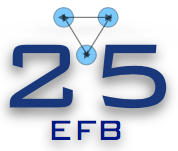Speaker
Description
In our contribution, we shall discuss our work at the interface of nuclear ab initio theory and nuclear density functional theory (DFT).
DFT is a powerful and versatile method in nuclear structure theory, with a wealth of application to ground state and collective excitations over the whole nuclear chart, as well as infinite nuclear matter [1].
The key object on which DFT is based on is the nuclear energy density functional (EDF). Current phenomenological EDFs, which are constrained by experimental measurements of nuclei close to magicity, are rather successful in reproducing stable nuclei. However, there are well-known shortcomings when they are applied e.g. to nuclei far from the stability valley of current interest for experimental nuclear physics and for their impact on modeling astrophysical scenarios. New strategies should thus be explored.
Our work aims at exploiting parallel developments in ab initio nuclear theory to devise a new methodology to build new EDFs. The motivation lies in the fact that ab initio, that describe nuclear systems starting from the interactions between their constituent nucleons, allows to determine the properties of nuclei and nuclear matter in a potentially unbiased way [2]. However, ab initio can be applied to heavy systems only in few selected cases and at a very high computational cost. Therefore, a combination of the flexibility of the DFT approach and the accuracy of ab initio has to be searched for [3].
We will present infinite nuclear matter conducted within the frameworks of Quantum Monte Carlo (QMC) and Self-consistent Green's function (SCGF). Specifically, QMC calculations of the equation of state (EOS) and the response of nuclear matter to a static potential [4] are shown, and we motivate that matching the ab initio and the DFT static response [5] allows to set constraints on the gradient terms of the EDF.
Then, a new, state of the art approximation scheme for the SCGF method, the so-called algebraic diagrammatic construction (ADC) that has been employed successfully to study finite nuclei, is applied to nuclear matter [6].
The overall purpose of our research is to establish a closer map between our microscopic understanding of nuclear structure based on nuclear forces and the effective, "high-level" description of nuclear systems provided by DFT.
References
[1] G. Colo', Advances in Physics: X 5, 1740061 (2020)
[2] H. Hergert, Frontiers in Physics 8, 379 (2020)
[3] F. Marino et al., Phys. Rev. C 104, 024315 (2021)
[4] F. Marino et al., Phys. Rev C. 107, 044311 (2023)
[5] M. Buraczynski et al., Physics Letters B 818, 136347 (2021)
[6] C. Barbieri and A. Carbone, Lect. Notes Phys. 936, 571 (2017)

